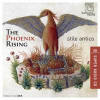Texte paru dans: / Appeared in:

Fanfare Magazine: 37:3 (01-02/2014)
Pour
s'abonner / Subscription information
Les abonnés à Fanfare Magazine ont accès aux archives du
magazine sur internet.
Subscribers to Fanfare Magazine have access to the archives of the magazine
on the net.
Harmonia Mundi
HMU 807572

0093046757267 (ID327)
Consultez toutes les évaluations recensées pour ce cd
~~~~ Reach all the evaluations located for this CD
Reviewer: J. F. Weber
This disc is a splendid way to mark the centenary of Carnegie UK Trust, for the benefactor was the source of funding for the Tudor Church Music series published from 1922 to 1929, as it is also for this recording. Only 10 of the planned 20 volumes of music were published, but Clifford Bartlett notes that transcriptions for the last 10 volumes to be edited for publication were on the shelves of a London library even after the War. The original editor was dismissed early in the game, Richard R. Terry, who alone early in the century was reviving Tudor church music at Westminster Cathedral, especially that of William Byrd. It was no credit to the Carnegie UK Trust that they pulled the plug on the project as unable “to justify the belief that the recovered music is likely to take a prominent place in the ordinary church choir repertoires.” The annotator supplies the quotation and remarks, “How wrong they were!” The reason was the octavo editions of individual works, which sold much better than the 10 library volumes and did indeed bring Tudor music into wide use and general awareness. The contents of these editions remain among the most well-known Tudor works even today.
The disc contains 10 works ranging from John Taverner to Orlando Gibbons (the two English-texted pieces are from Gibbons). The major work is William Byrd’s Mass for Five Voices, which makes a perfect foil to the classic Hilliard Ensemble’s set of all three Masses (Fanfare 8: 6). Unlike that set, sung one voice to a part, this group uses 13 singers. That may seem to make all the difference, but Stile Antico is one of the finest vocal ensembles in today’s concert scene and the voices blend as one. The movement timings of the two versions are within a few seconds. The Mass is divided into its four liturgical sections (only the Kyrie and Gloria are united) with anthems inserted in between.
Taverner concludes the program with the longest anthem, O splendor gloriae for five voices, a work that builds to an impressive climax. It was previously recorded by Andrew Parrott (13:4), Harry Christophers (twice, 16:3 and 24:1), and David Skinner (35:4). Stile Antico takes the broadest tempo, a full minute longer than Skinner, the runner-up. The breadth of the TCM project serves to place Thomas Morley, primarily a madrigalist, and Gibbons, belonging to a later generation writing little for the church and all of it to English texts, among the other composers instantly recognizable as Tudors. Gibbons’s O clap your hands, one of his most familiar works now, is an effective setting of a Psalm (46/47) that has attracted many composers. It may be compared to Byrd’s Ave verum corpus, certainly his most recorded piece (a reminder of Mozart’s equally unavoidable setting of the same text). Oddly unfamiliar is Robert White’s Portio mea, a section of the lengthy Psalm 118, recorded only by David Wulstan (5:5; CD in 12:1) and Peter Phillips (18:6).
The program flows together effortlessly. This chamber choir (if that is what you call singers without a leader) has a recognizable tonal signature that is audible throughout its discography, of which I have reviewed six earlier issues. The surround sound is unobtrusive, but this is not music that cries out for spectacular sound effects. If you know this group, you will not be disappointed. If you do not, you must hear a remarkable singing ensemble.
Cliquez l'un ou l'autre
bouton pour découvrir bien d'autres critiques de CD
Click either button for many other reviews


